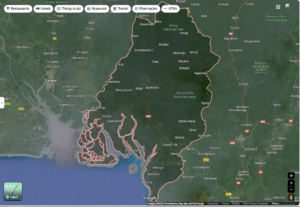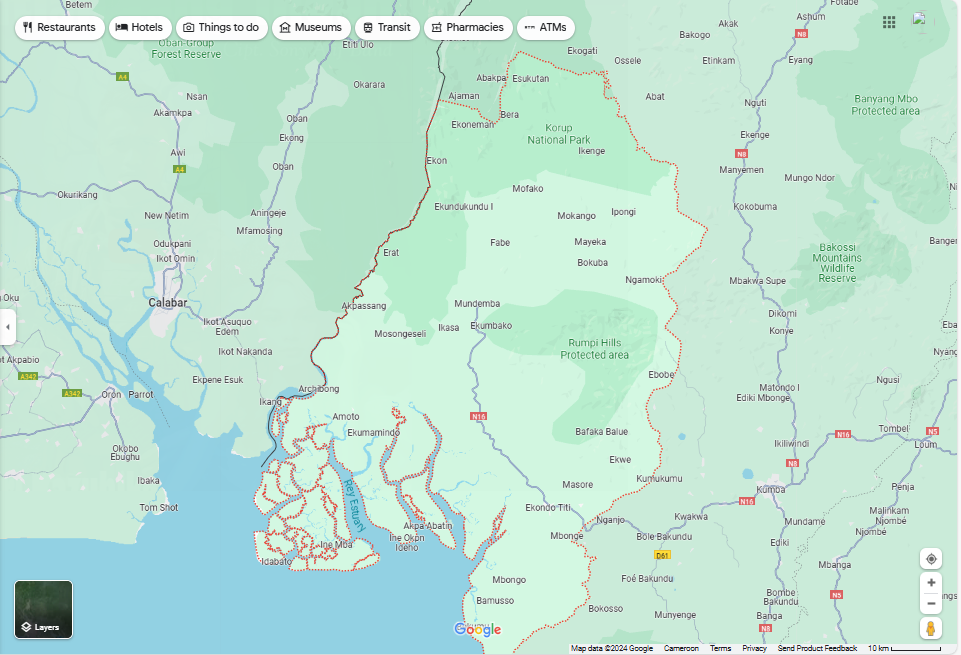THE ORKO PEOPLE
The Oroko, also known as Bareka or Batekka, are a Bantu ethnic group from the coastal Sawa region, residing mainly in the Ndian and Meme divisions of Cameroon’s Southwest Region. They communicate in Oroko, English, and Cameroon Pidgin English. The Oroko share historical and cultural ties with various coastal tribes in Cameroon, such as the Bakweri, Bakole, Duala, and others, all linked by a common heritage.
Geographical Footprint

The Oroko inhabit areas ranging from the mangrove plains of Ndian and Meme to the Rumpi Hills, adjacent to the Bakossi Mountains and Ejagham forest. The Ndian and Meme rivers, along with the Massaka and Makunge rivers, are crucial to their history, influencing their migration and settlement patterns. There are over 250 Oroko settlements, with Ekondo Titi and Dikome Balue being notable ones.
Cultural Landscape
Most Oroko communities are rural, with large villages often housing more than 3,000 residents. Their culture is intertwined with neighboring ethnic groups, and they claim to have established the Ekpe society, a peacekeeping masonic-like organization, and its associated script, Nsibidi. The term ‘nsibidi’ might originate from the Oroko word ‘njibidi,’ meaning ‘violence’ or ‘chaos.’ While the Ekpe society has been adopted by other groups like the Ejagham and Efik, the Oroko also share cultural elements like the Malle (Elephant cult) and Nganya with tribes such as the Bakweri and Bamboko.
Linguistic Diversity
Oroko language falls under the Narrow Bantu category, classified as A.10 in Guthrie’s system. It consists of nine dialects: Londo, Lolue, Lokoko, Lotanga, Lokundu, Lokombe (Ekombe), Longolo, Loma (Bima), and Lombongi (Mbonge). These dialects are sometimes regarded as distinct languages by some linguists.
View Map:
Self-awareness is rooted in understanding one’s origins and their impact on the present and future. This concept was echoed by Marcus Garvey, a prominent Pan-Africanist leader, who believed that a lack of historical and cultural knowledge is akin to being rootless. This notion is particularly relevant to the Oroko people, who have been recognized for their shared language and culture. However, the concept of a unified Oroko identity has faced scrutiny, with some viewing it as a political strategy or a threat to cultural integrity. This article explores the deeper connections beyond these superficial ties, examining oral and written histories to uncover the true essence of the Oroko identity.
The Term ‘Oroko’
The term ‘Oroko’ is a recent development used to describe an ethnic group predominantly found in the Ndian and Meme divisions of Cameroon, post-independence. Historically, these people were known as Balondo or Bakundu, names given by outsiders during colonial times. The term’s novelty has led to questions about the Oroko’s true identity and whether they share a common ancestry or are a diverse group united by language.
Debating Oroko Identity
Social media has sparked debates about the Oroko’s origins and unity. Two main theories have emerged: one suggests a shared ancestry and origin within the Fako and Ndian divisions, while the other proposes that the Oroko tribes, though culturally and socially connected, do not share a common ancestor.
Theory of a Common Ancestral Origin
The Oroko lack a unified narrative of their origins, likely due to the loss of oral histories during colonialism and Christian influence. However, ancestral tales trace back to Mount Cameroon, suggesting a common progenitor named Teke or Teka. These stories link various Oroko tribes to a man named Ngoe, believed to be the son of Nambongo or Mboe, and detail their migration following a volcanic eruption. The concept of a shared origin is further supported by historical conflicts known as the Batanga Wars and connections to the Batanga nation, which thrived before the slave trade era.
Theory of Multiple Origins
Contrasting the common origin theory, some argue that the Oroko tribes have always been distinct. Critics of the unified Oroko identity claim it obscures the true history of tribes like the Balondo. Others suggest that the Oroko are a confederation of historically independent tribes that formed a collective identity out of necessity.
Culture and Society
The Oroko, situated at the edge of the Bantu nation, exhibit a blend of their indigenous culture and influences from neighboring groups. They speak a northwestern Bantu language with several dialects and have complex religious practices centered around the worship of Modimo, a terrestrial spirit. Politically, the Oroko favor a republican system over monarchy, with community decisions made by collective assemblies.
Conclusion
The origins and culture of the Oroko are complex and cannot be fully captured in a brief account. Despite varying opinions on their unity, it’s likely that the Oroko once shared a common ancestry and location. Historical records and oral histories suggest that the Oroko were part of powerful nations along the Rio del Rey and the Cameroons River, with migrations traced back to the vicinity of Mount Cameroon. The concept of servitude within the Oroko society is also examined, indicating that it may not have been a marker of difference but rather a common practice among people of shared ancestry.
This article provides a condensed overview of the intricate history and identity of the Oroko people, highlighting the ongoing discussions and research into their past.
